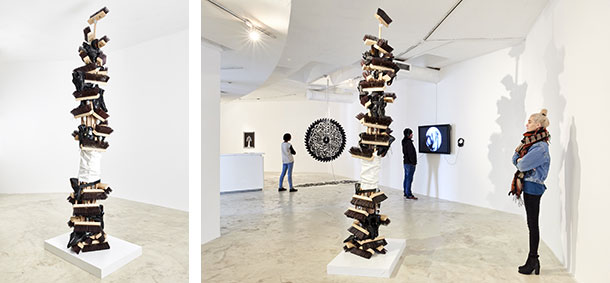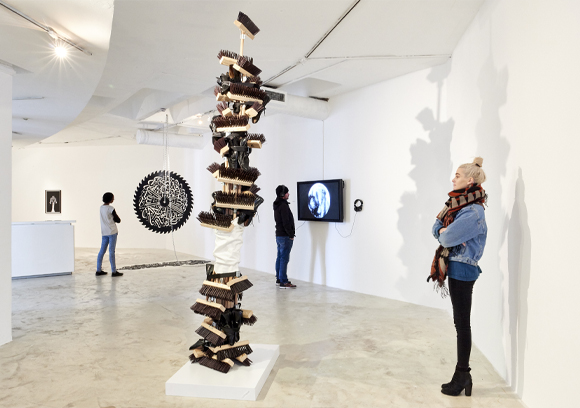| |
|
|
45.
| Monument to our fathers |
| |


2017, brooms and shoes, 300 x 100 x 70 cm
Exhibition view from Fragmented Memory, Goodman Gallery, 2017, Johannesburg.
Courtesy of the artist.
Ed. of 5 + 1 A.P.
“Monument to our Fathers, a tall totem composed of brooms, shoes, white material and industrial black packing belts. His play on words alludes to not only every human’s search
for their sense of belonging, but also his own personal heritage and history.”
Nicola Kritzinger, Arthrob, May 2017

Monument to our fathers
Exhibition view from Fragmented Memory, Goodman Gallery, 2017, Johannesburg.

Monument to our fathers
Exhibition view from Fragmented Memory, Goodman Gallery, 2017, Johannesburg.
|
|
|
|
|
|
Structure verticale de trois mètres de hauteur, hérissée de balais à brosse et de chaussures, la sculpture « Monuments à nos pères" est entourée dans sa partie basse d'un carré de tissu blanc étroitement noué.
L'œuvre évoque la situation politique et sociale des pays arabes et africains et aborde les questions du colonialisme et de ses prolongements contemporains, désignés sous le terme de post-colonialisme. La sculpture fonctionne comme un « totem » ou un « monument » destiné à « une génération qui a tout perdu ». mounir fatmi a évoqué dans différents entretiens journalistiques la situation des sociétés arabo-africaine paternalistes et de leurs régimes dictatoriaux ̶ sociétés figées et autoritaires, souvent corrompues et coupées des aspirations de la jeunesse, au sein desquelles vit une population majoritairement très jeune et « assoiffée de liberté, de démocratie et de justice ».
Monuments à nos pères peut être mise en lien avec d'autres sculptures réalisées par mounir fatmi, notamment « Les Printemps perdus » qui traite des Printemps arabes et recourt au balais à brosse, ou « Civilisation », où apparaît la chaussure en tant qu'élément de civilisation des individus. Le motif de la chaussure renvoie à L'Enfant sauvage de Truffaut, film dont plusieurs œuvres de mounir fatmi s'inspirent afin d'interroger le langage et l'éducation. Il est également associé dans les souvenirs de l'artiste et dans l'imaginaire collectif à une image médiatique marquante, celle du journaliste irakien projetant ses chaussures à la figure de George Bush (qui décida de l'intervention américaine en Irak en 2003) en pleine conférence de presse, en 2009.
Totem et monument, l'œuvre fonctionne comme un emblème et une forme de commémoration. Elle constitue le symbole d'une révolte contre l'autorité patriarcale. Dans une acception psychanalytique, « Monuments à nos pères » fournit les armes nécessaires pour tuer le Père : la chaussure pour combattre le paternalisme de l'impérialisme européen ou américain et le balais contre l'autoritarisme des sociétés arabes. Œuvre symbolique et ancrage mémoriel, la sculpture maintient vivant dans les consciences des jeunes générations le souvenir d'un acte de révolte fondateur. Si le carré de tissu blanc est un drapeau, alors celui-ci ne reprend les couleurs d'aucun drapeau national et il ne flotte pas non plus au sommet de la structure. Il n'est pas question ici d'orgueil national ou d'identité, mais de territoires vierges, à constituer, à construire et à renouveler. Il est avant tout question de désir d'émancipation et d'aspiration au changement.
Studio Fatmi, Novembre 2017. |
|
A three-meter high vertical structure spiked with scrubbing brooms and shoes, the sculpture « Monument to our fathers » is surrounded at its base by a tightly knotted square piece of white fabric.
The work evokes the political and social situation of Arab and African countries and tackles the question of colonialism and its contemporary repercussions designated with the term « post-colonialism ». The sculpture acts like a « totem » or a « monument » dedicated to « a generation that lost everything ». In numerous interviews in the media, mounir fatmi has talked about the situation of paternalistic Arab and African societies and their dictatorial regimes – rigid and authoritarian societies, often corrupt and cut off from the aspirations of their youth, among which lives a predominantly young population « hungry for freedom, democracy and justice ».
« Monuments to our Fathers » can be linked to other sculptures created by mounir fatmi, for instance « The Lost Springs » that deals with the Arab Spring and also uses scrubbing brooms, or « Civilization », where the shoe appears as an element for the civilization of individuals. The shoe is a reference to « The Wild Child », a film by François Truffaut that inspired several of mounir fatmi’s pieces, used to question language and education. It is also closely linked in the artist’s imagination as in our collective memory to a memorable news image, that of an Iraqi journalist throwing his shoes to George Bush’s face (who decided on the American intervention in Iraq in 2003) in the middle of a press conference in 2009.
A totem and a monument, the piece works like an emblem and a type of commemoration. It constitutes the symbol of a revolution against patriarchal authority. In a psychoanalytic sense, « Monument to our Fathers » provides the necessary tools for the killing of the Father : the shoe to fight the paternalism of European and American imperialism and the broom against the authoritarianism of Arab societies. The sculpture is a symbolic work and a memorial anchor that keeps alive the memory of a founding revolutionary act in the conscience of young generations. If the square white cloth is a flag, it doesn’t borrow the colors of any national flag, nor does it wave from the top of the structure. This isn’t about national pride or identity, it’s about virgin territories that still need to be defined, built and renewed. Above all, this is about a desire for emancipation and the aspiration for change.
Studio Fatmi, November 2017.
|
|
|
|